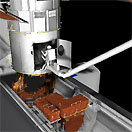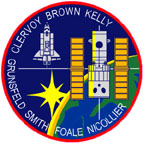

|
 HST
SM3A stands for Hubble Space Telescope Servicing Mission 3,
Part 1. This important mission is a special tune-up to keep
the telescope healthy for the next 10 years. HST
SM3A stands for Hubble Space Telescope Servicing Mission 3,
Part 1. This important mission is a special tune-up to keep
the telescope healthy for the next 10 years.
A
Space Shuttle crew blasts through the atmosphere of Earth
and into space to reach the telescope. When the Shuttle reaches
the telescope, the astronauts use the Shuttle's robotic arm
to catch it in mid flight and perform a 370 mile (595.33 Kilometers)
high house call. They attach Hubble to a pivoting, turntable-like
ring inside the Shuttle's cargo bay.
 Once
Hubble is firmly anchored to the Shuttle, they grab their
tools and equipment and leave the Shuttle to replace equipment
and upgrade the telescope. Once
Hubble is firmly anchored to the Shuttle, they grab their
tools and equipment and leave the Shuttle to replace equipment
and upgrade the telescope.
|
|
 Hubble
can view the deepest areas of space and record pictures of
stars, nebulae, galaxies, and planets. In
a way, Hubble
"eats" light, digests the information and sends
it to us as pictures. Hubble
can view the deepest areas of space and record pictures of
stars, nebulae, galaxies, and planets. In
a way, Hubble
"eats" light, digests the information and sends
it to us as pictures.
The Earth is very bright and reflects the Sun's light. That
light and other things in Earth's atmosphere act like junk
food. Ground telescopes fill up on atmospheric junk food,
which makes them unable to see as far or as clearly as a telescope
in space.
Space
is like an all-natural, light meal! A space telescope can
be Earth-light free and devour the good stuff like black holes!
Hubble can see light from stars and other space objects without
filling up first on Earth's light. These deep space lights
become clearer and more defined with every new instrument
and improvement to Hubble.
|
Because
Hubble has no spares, it is very important to service the
telescope before another gyro breaks. NASA planned the third
Hubble check-up for the year 2000.
To
make sure Hubble keeps delivering great pictures, NASA decided
to divide duties for the Third Servicing Mission into two
separate missions: A and B.
|
|
Your
mom says it is past your bedtime. Dad says you have
school tomorrow. But you want to stay up late. After
a while, you can't keep your eyes open. When you try
to open your eyes to see the TV, you are just too
tired to make sense of the fuzzy pictures! Even getting
a glass of water is tough when you are sleepy! You
can't even find the sink!
Hubble
is just like you! The same thing happens to Hubble
when not enough of its gyroscopes work. Hubble goes
into Safe Mode or Safe Hold, which is like sleeping.
Its eyelid (aperture door) now covers Hubble's eye(lens).
Without at least three gyros working, Hubble can't
keep its eye open or focus clearly on the sky. Hubble
is completely healthy, just merely "sleeping" until
it has enough working gyroscopes.
When
the astronauts replace the old gyros for new ones,
Hubble will be able to open its eyes and see! Hubble
can then focus on and snap photos of targets like
stars. Hubble can tell clouds of gas swirling around
deep space, "SAY CHEESE!"
|
|
|
|
|
Hubble
moves around the Earth in a path called an orbit. The Earth
holds you to the ground, by a force called gravity. This same
force pulls on Hubble, even hundreds of miles up.
If
you swing a yo-yo around in a circle, the string keeps it
from flying off. The Earth's gravitational pull is like a
string that holds Hubble in its orbit.

-
Hubble
orbits the Earth about every 96 minutes, or every 1 �
hours. That is 24,901.55 miles (40,066.59 Kilometers)!
-
Every
minute, Hubble travels 276 miles (444.08 Kilometers)!
The fastest human ran a 3-minute mile. Hubble
moves 828 times faster!
-
Friction
causes the decline of speed. A bike moves faster than
a runner, because less surface area (the amount of tire
versus the amount of foot) touches the ground. The ground
actually slows you down, whereas, in the vacuum of space,
there is very little friction to hold back Hubble's speed.
|
Hubble,
without a spare...
(gyros,
Rate Sensor Units)
|

Just like keeping a spare tire in a car, it's smart
to have spare gyros on Hubble if others break. The
gyros are part of a system that points the telescope
at stars. Gyros sense and report the telescope's position.
Hubble has six gyros, and three of these are spares.
 Until
November 13, 1999 Hubble had been using all three
spares right now because the first three gyros broke.
Another one broke on November 13th and now it only
has two. Astronauts will walk into space to deliver
six new gyros to Hubble. These gyros are packaged
in three new Rate Sensor Units, with two gyros in
each unit. Until
November 13, 1999 Hubble had been using all three
spares right now because the first three gyros broke.
Another one broke on November 13th and now it only
has two. Astronauts will walk into space to deliver
six new gyros to Hubble. These gyros are packaged
in three new Rate Sensor Units, with two gyros in
each unit.
|
|
Shuttle

Crew
Information
|
|
Back
to Top
|